Faced with the improbability of superluminal travel, many authors have decided to opt for sublight starships. True, sublight travel has significant challenges (slow travel, high energy demands) but at least it doesn’t necessarily break causality. Is it possible to tell interesting stories without faster-than-light travel? Yes indeed! Consider these five tales of sublight exploration and trade.
Rogue Queen by L. Sprague de Camp (1951)
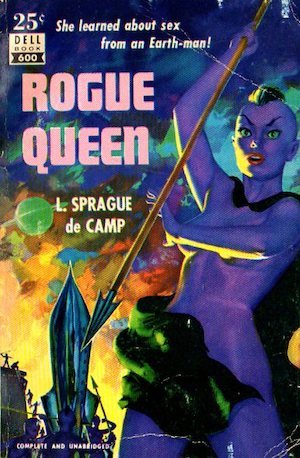
The natives of the planet Niond (or as humans deem it, Ormazd) are superficially human, but in important ways they are more like ants and bees. Each community has a ruling queen who produces all the children. The workers and warriors are sterile females, while males are relegated to reproductive duties until such time as they are deemed surplus to needs and eliminated. But Ormazd as a whole isn’t unified. Different communities can find themselves at loggerheads, as do the worker-caste Avtiny and their aggressive Arsuuni neighbours.
Enter the human interstellar visitors.
Interplanetary Council rules forbid arming the Avtiny against the Arsuuni, not matter how adorable the researchers on board the NAFAL starship Paris find the Avtiny. Nevertheless, it doesn’t take the Paris scientists long to pick a side in the Avtiny-Arsuuni conflict. Not only that, they stumble across a biochemical secret that will upend Ormazdian society. They can save their pet Avtiny at a cost: complete transformation of their culture.
***
Rissa Kerguelen by F. M. Busby (1977)

The 21st century is a veritable utopia, governed by United Energy and Transport (UET). A utopia, that is, where peace and security are assured by rigid class stratification and a punitive justice system. Few of the cowed citizens can imagine a better way of life. Those who do can look forward to midnight visits from large, unfriendly UET minions.
While winning the lottery might be seen as a forgivable mistake, welfare orphan Rissa Kerguelen commits the unforgivable sin of wanting to keep her winnings. UET’s reach is long and there is no safe place on Earth for reprobates like Rissa. But Earth is not Rissa’s only option. Head out for the stars on a sublight starship and she might escape UET…if she is willing to take the long view.
***
The Doppelgänger Gambit by Lee Killough (1979)
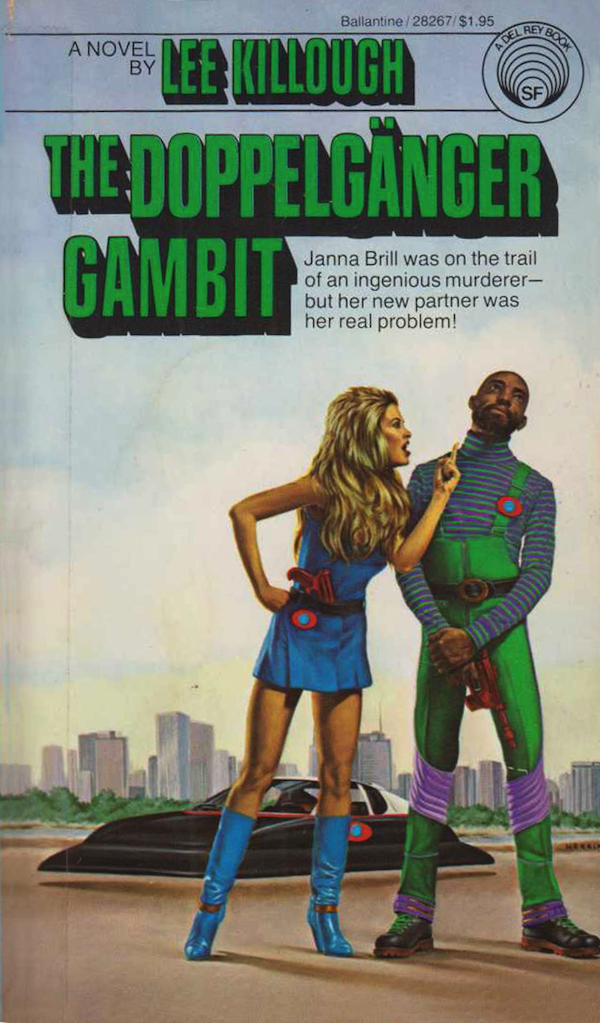
Bussard ramjets are a godsend to 21st century America, offering discontented citizens escape from governments they find onerous while also shoring up governments by ridding them of citizens who might otherwise agitate for change.
To starship broker Jorge Hazlett, however, sublight colonization means providing clients with Boeing Starmaster 800s in lieu of the more expensive, more durable Starmaster 1000s the clients thought they were buying. The difference goes into Hazlett’s pocket; the clients are sent off to some distant world from which they can never return to complain.
This flawless business plan is threatened when the starship Invictus manages to send out a distress call just before its life support fails. Now the authorities will take a close look at Invictus’ sale papers. Unwilling to face the penalties for killing nine hundred people, Hazlett sets out to frame his business partner, Kellner. Problem: Kellner must die lest he protest his innocence too convincingly. Getting away with murder in a panopticon state should be impossible, but visionary Hazlett is convinced he has found a loophole. It’s up to cops Brill and Maxwell to prove him wrong.
***
Skye-Object 3270a by Linda Nagata (2010)
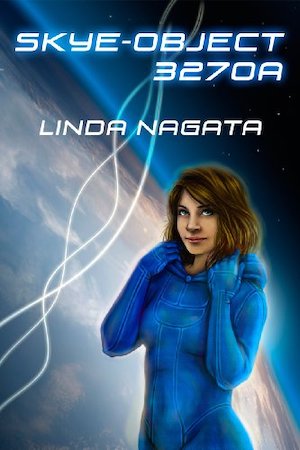
High above the planet Deception Well, orbital habitat Silk’s human inhabitants have all the essential tools for interstellar travel and trade. So did the ancient Chenzeme, who rather inconsiderately littered the interstellar region around Deception Well with autonomous weapons before going extinct. Interstellar travel in the human era is therefore extremely hazardous.
Protagonist Skye’s history is a matter of conjecture. She was only two years old when arrived in an interstellar life boat. The life boat sheds no light on her origins. Her rescuers have a plausible (if wrong) theory. That’s not enough for Skye. She is determined to find the truth. She digs deep into all the records she can find, legally or illegally. In so doing, she uncovers an as yet unrealized threat that jeopardizes every single person in Silk.
Good news! There may be a solution. Bad news: Obtaining it means venturing down to the surface of Deception Well, whose Guardians are arguably as dangerous to humans as Chenzeme weapons.
***
Neptune’s Brood by Charles Stross (2013)
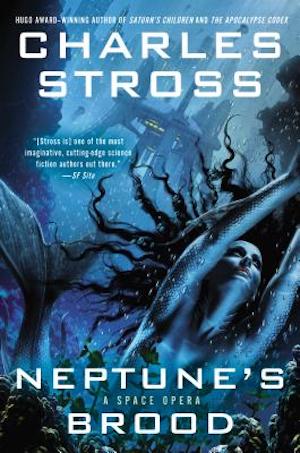
By AD 7000, interstellar colonization is financed by investments that pay off over centuries. The beneficiaries: intelligent robots who have taken over for the human race, which has an unfortunate tendency toward self-extinction.
Pursued by an assassin, Krina Alizond-114 arrives at ocean world Shin-Tethys seeking treasure. Relict of an ancient colonization scam, the fabled Atlantis Carnet is an encrypted financial instrument of unparalleled value…but only if both of its encryption keys can be recovered, something treasure hunters have tried and failed to do for millennia. Krina is in possession of one key. Her sister Ana on Shin-Tethys has the other. Their fortunes are assured—provided that the sisters manage to avoid death at the hands (manipulating appendages?) of those threatened by their discoveries.
***
There are, of course, many other examples I could have used, thrilling tales in which persons—human and otherwise—set out with marvelous engines of light (Easter egg!) No doubt you have favourites whose absence on this list outrages you. The comments are below.
In the words of Wikipedia editor TexasAndroid, prolific book reviewer and perennial Darwin Award nominee James Davis Nicoll is of “questionable notability.” His work has appeared in Publishers Weekly and Romantic Times as well as on his own websites, James Nicoll Reviewsand the Aurora finalist Young People Read Old SFF (where he is assisted by editor Karen Lofstrom and web person Adrienne L. Travis). He is a four-time finalist for the Best Fan Writer Hugo Award and is surprisingly flammable.










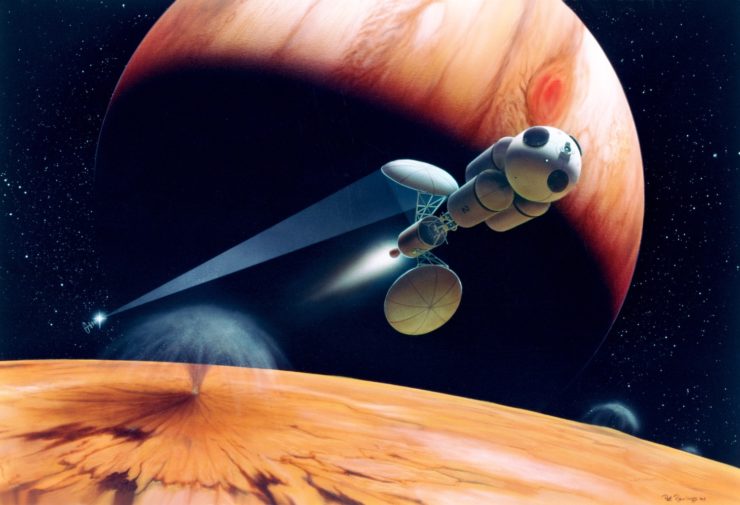
More possibilities than you can shake a stick at, plus the stick. Heinlein with “Orphans of the Sky” with a broken and failing society and ship , Niven’s “Known Space” in the pre-hyperdrive era with tech that worked reasonably well, the societies not so much.
A STL generation ship was the setting for the Canadian TV show “Starlost” which you, being Canadian, may have suppressed your memories of. Apparently it was worse than even the usual SyFy channel production.
I’ve reviewed Starlost! Twice!
https://jamesdavisnicoll.com/review/terrible-things
the great gatsby tells a compelling story of a sad guy without faster-than-light travel. it’s a good book should be on this list
All of Alistair Reynolds’ Revelation Space stories feature sublight only travel. An attempt to achieve FTL creates causality disturbances and erases people out of existence! Without giving FTL!
Vernor Vinge’s Fire in the Deep. The story is set in the Slow Zone of the Milky Way where FTL is impossible.
Ursula Le Guin used the time-dilation effects of the NAFAL (“nearly as fast as light”) drive to good effect in many of her stories.
Ken MacLeod’s Corporation Wars fits the bill.
Then there’s Robert Reed’s Greatship series.
And all of Linda Nagata’s stuff in the same setting as Skye-Object 3270a.
And much, much more.
Chitnis, you mean A Deepness in the Sky. A Fire Upon the Deep involves a lot of FTL.
What about Frederick Pohl’s Starburst?
Is Starburst the expanded version of The Gold at the Starbow’s End? I preferred the shorter original to the novel length version.
Some examples:
Pat Murphy’s There and Back Again, which I just happened to read last week. It unfortunately plays fair with the STL travel and light-speed communication for most of the book and then doesn’t at the climax.
Dave Duncan’s Hero!, which is also a good example for (lack of) stealth in space: the ships are so un-stealthy that they can be mistaken for quasars.
Glad folks are mentioning Vernor Vinge’s A Deepness in the Sky. My personal favorite slower-than-light star-spanning adventure. And one of the rare times I liked a prequel!
Arthur C. Clarke: The Songs of Distant Earth, which Clarke referred to as his favorite of his novels, is about a lost colony being rediscovered (sort of). Also Rendezvous with Rama and its sequels, involving alien STL ships.
The Bobiverse, starting with We Are Legion (We Are Bob), provides the nerdgasm that Ready Player One failed to deliver, and involves significant amounts of STL star travel.
Cixin Liu, The Three-Body Problem and its sequels, but to say more would be spoily.
Poul Anderson, Tau Zero, a stone classic of hard SF (though one of its big goshwow premises is now consigned to the scrapheap of scientific history).
The sources I mobile-googled suggest no reason to abbreviate Transport with L.
Michael Flynn’s The Wreck of the River of Stars is a wonderfully-written book centered on the workings of STL travel. More character-driven than much SF, but really worth passing around.
Ah, I should have been clearer: I meant interstellar STL.
About the cover of the Lee Killough: while the cops have holsters, otherwise the cover faithfully depicts the fashions as described in the book.
Ues, it would be interesting to have a list of within-planetary-system FTL, if five books could be found at all. I guess it dissolves into ordinary teleportation…
Huh. You know, I am sure I read something where the setting had ftl with the drawback drives burned out almost immediately, so you could go very very fast over short distances. Drives carried as cargo also burned out. Now, I cannot see why one could not stage a long string of FTL drives using conventional rockets but nobody had gone to the bother.
I guess the Queendom of Sol books count: it has a local communications system that can break lightspeed but only within the network, which by its nature would be very challenging to extend between stellar systems.
@16: per the Little Black Rule, Traveller mentions that it is occasionally useful to jump within a system, if where you want to go is a week or more away and it’s worth burning the fuel.
@7 Oh yeah! My bad!
@17: shades of 2300 CE, where the expedition to the Pleiades brought along a few extra stutterwarp engines so they could make a few transits of more than 7.7 ly. The extras had to be kept offline or they would build up the same gravomagnetic charge as the active engine, and onlining one is a finicky process requiring skilled hands, which is why robot probes can’t use the technique (also, tantalum-180m doesn’t grow on trees).
Ben Bova’s “Stars Won’t You Hide Me” features a human civilization that spans the Milky Way at the least despite being limited to near light speed travel. On the plus side, this limit means when the superior civilizations finally reach their limit of tolerance for humans, it’s very hard to kill all of us before the clock runs out on the universe.
I really liked the Kerguelen books when growing up (though not so much after they went FTL). That said, I remember United Energy and Transport being UET (“the uties”), not UEL.
That is a weirdly consistent typo. Dear editors, please replace UEL with UET.
@22, 23: Fixed, thanks!
Joe Haldeman’s The Forever War uses STL and the resulting time displacement in really cool ways.
One of the best of the early Bantam Star Trek tie-ins, David Gerrold’s The Galactic Whirlpool, concerns the rescue of a sublight generation ship that will, if left to itself, fall into a particularly nasty black hole. This being Gerrold, the tale is not without a humorous component, as a budding conflict between two sets of passengers is resolved by the application of prowlers and growlers and bears. “Especially the bears, Mr. Spock. Especially the bears.”
An early favorite of mine is Heinlein’s “The Rolling Stones” with it’s fun info dumps on cometary orbits and such.
@2: You broke open the dam with your comments–now, I’ve seen quite a few Canadian series (including Canadian SF), and I have to know what you consider the some of the worst Canadian TV shows ever (including possible SF one, The Starlost excluded).
The Trouble With Tracy probably holds the record for worst Canadian show with the most number of episodes: 130 in season one (which was also the only season).
Rocheworld by Robert L Forward. Interstellar travel by laser drive light sail with the crew does with the drug NoDie that extends their lifetimes at the temporary loss of mental faculties. The robotic Christmas Bush keeps the child like crew alive until they arrive at Barnard’s Star.
My nerd eye was pretty sure it saw a Tardis in that Neptune’s Brood cover. Then the no-fun eye ruined it.
Kim Stanley Robinson‘searly book A Memory of Whitness. And indeed most of his other space operas as well. No FTL in Aurora either.
You said space travel, not outer space. Jay Gatsby drives around…
Wikipedia has a lot to say about that book, but not about a science fiction version, let alone interstellar. “The Great Bird of the Gatsby”? “Fitzgerald and Empire”? “Dine”?
I don’t think it’s part of Niven’s Known Space, but The Fourth Profession has alien salespeople traveling the universe on solar sails
I think that Niven is usually counted as part of his Leshy Circuit setting.
@35: The bibliography in Tales of Known Space does. Then, said bibliography also puts “Rammer” in the Leshy Circuit ‘verse, despite being blatantly incompatible with the other listed stories.
I’m surprised no-one has taken a bite of the Easter Egg. *Engines of Light*, indeed! Good old James was alluding to Ken MacLeod’s *Engines of Light* trilogy. Namely, *Cosmonaut Keep* (2000), *Dark City* (2001), and *Engine City* (2002). Strictly speaking, the interstellar travel was at lightspeed itself. Effectively, transiting through something like a hyperspace and emerging at their destination as if the trip was at lightspeed. But this gave them one heck of huge slab of time dilation. A very enjoyable set of books. Anyone who likes highly inventive SF and a good story, with a political sensibility, will have fun with them.
Greg Egan’s interstellar stories almost never have FTL. Diaspora even had the characters trying and failing to travel faster than light using wormholes.
About Linda Nagata’s Sky Object…
It should be mentioned that it’s part of a growing book series – the Nanotech Succession – and that online information about which books, exactly, constitute it, might be misleading. As an example, I’ve only just figured out Sky Object was a part of it and that I should read it ASAP.
Currently the reading order is:
The Bohr Maker, Deception Well, Skye Object*, Vast, Memory**, Edges, Silver.
*Not having read it yet I can only assume this is its place in the timeline
**An earlier standalone novel that Nagata decided could be made compatible with the Nanotech succession universe. Edges and Silver provide the connection so it can be read at any point before edges.
Additionally there is Tech Heaven, described by Nagata as a prequel to The Bohr Maker, but I always felt it provided little continuity or interest and could be left out.
Molly Gloss’s The Dazzle of Day, a beautiful story of a Quaker generation ship: the story is gripping yet gentle, and very distinctive.
I fear the cognitive cost to readers of a book where people savagely listen to each other patiently and then brutally work towards an ethical consensus through reason and empathy. Wouldn’t the living envy the dead?
Lockstep by Karl Schroeder is, what I thought, a mostly realistic take (ok, it did rely, heavily, on suspended animation) on how an interstellar civilization might develop.
Rob Greene’s very recent, and beloved-by-me take on STL’s social costs, THE LIGHT YEARS.
I reviewed it on my blog.
@9/JDN: You are correct.
If I remember, David Brin’s Glory Season was took place on a colony world (settled with a much gentler matriarchy than Sherri Tepper’s Six Moon Dance….), which was part of a very loosely knit human interstellar milieu connected by STL ships and solo agents (shades of Le Guin’s Ecumen!) sent as heralds. Of course, there was no FTL in his Existence (which I couldn’t finish). Another STL-only story by Dr Brin is “Crystal Spheres.”
Mary Doria Russell’s “Sparrow” books (The Sparrow and Children of God) are supposed to involved NAFAL travel, although I remember thinking the math didn’t work out — too long traveling a too-short distance for the time dilation specified (IIRC), and a lot of the skeleton hangs on the way events here and there line up.
Other Heinleins that depend on NAFAL travel: Time for the Stars (IIRC discussed in this series recently) and Methusaleh’s Children.
A side comment on The Starcrossed (since my web-fu isn’t up to finding how to put a comment on the above link): an essay in the front of the Bryant(-and-Ellison) novelization of the pilot, Phoenix Without Ashes, goes into some detail about how much of the series development was done by … less-qualified … hands because Ellison refused to write for the producers during a screenwriters’ strike. He specifically mentions someone admitting to not knowing anything about SF who later showed up as the ?series editor?, and the very brief post-pitch, during-the-strike recorded description of the background being transcribed into what little they had for a “bible”. As usual with Ellison, one must wonder how much he exaggerated and/or fabulated — but everything in the essay seems plausible.
In Larry Niven’s short story “Rammer” (1971) and its novel expansion A World Out of Time (1967), a corpsicle is revived by a future totalitarian state (the same one in The Integral Trees, at least as organized on the ISFDb entry) and bargained into being a slowboat pilot to seed planets of nearby stars. He rebels and accelerates his ramscoop so he can return to Sol System several decamillennia later, by which time Neptune has been relocated.
In Charles Sheffield’s Tomorrow and Tomorrow (1988) a man follows his cancer-patient wife into the future via cryonics, then inadvertently perma-kills her by opening her cabinet for a peek at the wrong moment, during a slowboat trip that future-civilization bargained him into. Much slow travel follows until the universe reaches a point where her identity can be retrieved.
John C. Wright’s six-book “Eschaton Sequence” (Count a Trillion (2011) et seq.) is built around a love that spans the stars! <trumpet fanfare>. The genius queen of humanity jets off to a distant star cluster to beg mercy from the overlords of this corner of the universe (or so we believe), while her Texan love (buried by a falling-building coup attempt) obstinately awaits for her return for 30,000 years and more via successive means of life-extension, including nanotech-aided stasis cabinets, transhumanism, and having his identity transcribed by aliens.
@46 I believe you meant “The Starlost” (the TV show), but in Ben Bova’s The Starcrossed (his satire of the experience; he had been hired as a science consultant) does include some of the same details.
It’s not quite corroboration, but it does seem that the production was especially bad.
And not a word about Bova’s early Planet books all done a less than FTL.
The work by L. Sprague DeCamp was, I believe, only one of a number of books about the Viagens Interplanetarias (I think—most of my DeCamps are in a box someplace). All these dealt with NAFAL star travel, many involving the exoplanet Krishna.
I believe any DeCamp title including a proper name beginning with Z take place on Krishna, and are thus part of this set of novels. I remember them as great fun to read.
50: I believe that you are correct.
The comments about Starlost reminded me of a satire of the Canadian TV industry called Made in Canada which does feature an in-show fantasy series called “The Sword of Damocles” with a somewhat dim lead actor.
Ender’s Game is a hybrid; it has faster than light communications but slower than light travel.
Starship by Brian Aldiss and already mentioned Orphans of the Sky by Heinlein as well as his Time for the Stars remain my favorite sublights
52: I think Sword was supposed to be a parody of Hercules.
53: Oh, indeed it was.
#25 Joe Haldeman’s hard SF novelette “Tricentennial” also does interesting things with STL (if near-FTL) travel, with a melancholy ending that sticks in my mind 40+ years since I read it.
https://reiszwolf.wordpress.com/2020/10/27/tricentennial-1976-hard-sf-novelette-by-joe-haldeman/
The Turtles in the Liaden Universe have a slowboat type of drive, much slower than other stardrives–but I’m not sure if it’s slower than light.
58: The Turtle electron-substitution drive is slower, weird for humans, and energy-efficient, but most definitely FTL.
@@@@@ 59, zdamein
The Turtle electron-substitution drive is slower, weird for humans, and energy-efficient, but most definitely FTL.
The Turtle drive is slow on the lower registers, much faster on the higher registers. IIRC we learned that in I Dare. Low register or high, it’s still weird for humans.
“Colony Fleet” By Susan R Matthews – a fleet of generation ships. Problems ensue… (Mine is in a box: summary from the Large South American River; the dream is threatened, not the planet.)
What about Becky Chambers’ “The Long Way to a Small, Angry Planet”? It’s right there in the title! Humans have also used generation ships in her series to get to where they are now.
Ooh! I completely forgot about Robert Sawyer’s Calculating God, in which the various aliens all use slower-than-light travel. The slower-than-lightness is in fact a key point plot (can’t say more without spoilers. Unless I misremember the book entirely).